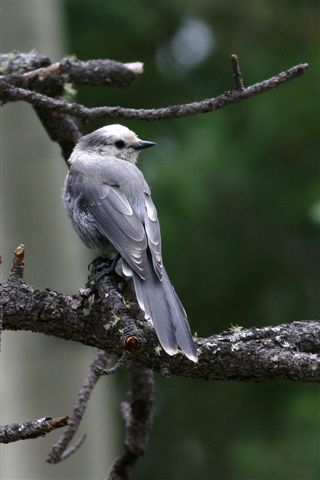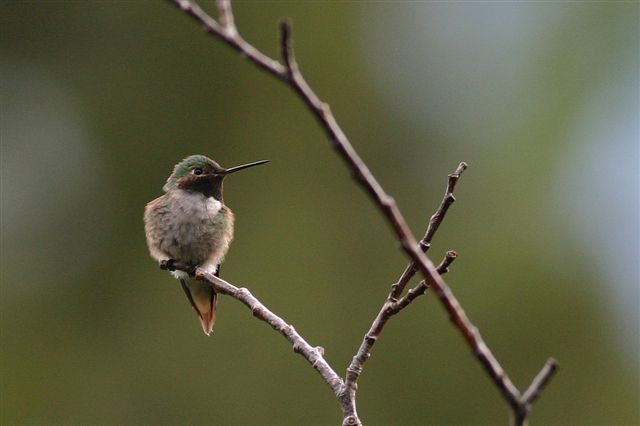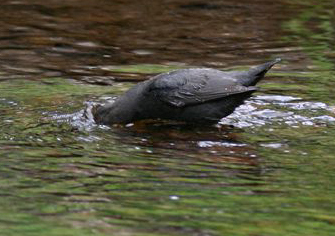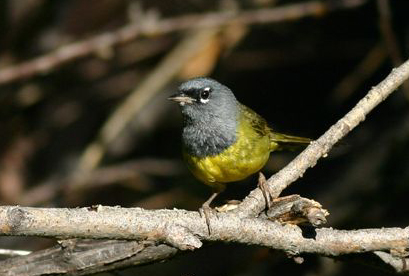 |
 |
|||||||||||||||||||||
|
||||||||||||||||||||||
AZFO FIELD EXPEDITION
White Mountains Survey Summary 8-9 July 2006
AZ Field Ornithologists' first Field Expedition was to the White Mountains in an effort to finally confirm nesting of Wilson's Warbler in Arizona. This species has never been documented nesting in Arizona, but during the past 3-4 years, there have been several tantalizing early to mid-July reports of individuals near Sheep Crossing along the West Fork of the Little Colorado River, including a possible juvenile observed. The closest known breeding areas are in north-central New Mexico and southwestern Colorado where they nest in similar high-elevation willow thickets.
 The nine AZFO member team surveyed the West Fork of the Little Colorado River near Sheep Crossing on 8 July and just upstream of Greer on 9 July. Although we failed to find any Wilson's Warblers, our efforts proved useful as we documented a number of pairs of other local nesting species along the surveyed drainage.
The nine AZFO member team surveyed the West Fork of the Little Colorado River near Sheep Crossing on 8 July and just upstream of Greer on 9 July. Although we failed to find any Wilson's Warblers, our efforts proved useful as we documented a number of pairs of other local nesting species along the surveyed drainage.
On the first morning (8 July) the teams split up and surveyed the willow stands immediately along the West Fork drainage above and below Sheep Crossing. Although approximately 3.4 km (2.1 mi) of drainage was surveyed, the best potential habitat for nesting Wilson’s Warblers appeared to be within 0.4 km (0.25 mi) of the actual Sheep Crossing. Apparently, this is also where most of the prior mid-summer observations for this warbler have been reported. The habitat consisted primarily of 2-3 m (6.5 – 9.8 ft) high Geyer and Bebb willow stands at an elevation of approximately 2800 m (9200 ft). Surveys upstream revealed that habitat quality rapidly declined upon entering the Mt. Baldy Wilderness Area with evidence suggesting heavy elk browsing of the willows. A good diversity of birds were found using the riparian habitat (Table 1).
Table 1. Bird species detected in the riparian vegetation along the West Fork of the Little Colorado River near Sheep Crossing.
| Species | # of individuals | Est. # pairs | Breeding Behavior** |
|---|---|---|---|
| *Broad-tailed Hummingbird | 6 | C | |
| *Rufous Hummingbird | 2 | O | |
| *Williamson's Sapsucker | 1 | FL | |
| *Red-naped Sapsucker | 4 | FL | |
| Dusky Flycatcher | 2 | 1 | # |
| Cordilleran Flycatcher | 3 | 2 | X |
| Warbling Vireo | 2 | 1 | ON (incubating?) |
| *Violet-green Swallow | 3 | # | |
| American Dipper | 2 | 1 | CF (NY?) |
| *Ruby-crowned Kinglet | 2 | FY | |
| American Robin | 6 | 3 | FL |
| Orange-crowned Warbler | 4 | 3 | P, X |
| Virginia's Warbler | 3 | 2 | P |
| *Yellow-rumped Warbler | 6 | FY | |
| MacGillivray's Warbler | 6 | 4 | CF, FL |
| Brewer's Blackbird | 4 | 2 | A |
| Green-tailed Towhee | 8 | 7 | CF, FL |
| Lincoln's Sparrow | 8 | 6 | CF, FL |
* Denotes species likely using riparian habitat for foraging or feeding fledge young and not for actual nesting.
** AZ Breeding Bird Atlas behavior codes: O – observe as nonbreeder only, # - individual present in appropriate breeding habitat and season, X – singing in appropriate nesting habitat, C – courtship/copulation, P – pair observed, A – agitated individual, ON – occupied nest, NY – nest with young, CF – carrying food, FY – feeding fledged young, FL – fledgling/juvenile observed
 An adult dark-lored White-crowned Sparrow discovered at Sheep Crossing was out of season and below typical breeding elevation in the state. Clark’s Nutcrackers, Golden-crowned Kinglets, Western Tanagers and Pine Siskins periodically called and flew over from the adjacent spruce-fir forest. Several pairs of American Robins were making a fuss in one willow stand and while two surveyors waited and watched, a Long-tailed Weasel loped out of the wet grass and quickly back under cover.
An adult dark-lored White-crowned Sparrow discovered at Sheep Crossing was out of season and below typical breeding elevation in the state. Clark’s Nutcrackers, Golden-crowned Kinglets, Western Tanagers and Pine Siskins periodically called and flew over from the adjacent spruce-fir forest. Several pairs of American Robins were making a fuss in one willow stand and while two surveyors waited and watched, a Long-tailed Weasel loped out of the wet grass and quickly back under cover.
Our base camp was at Sunrise Campground where a pair of Gray Jays visited us for breakfast handouts along with a very persistent and rather overweight Red Squirrel and Golden-mantled Ground Squirrel. After lunch we hiked near camp in search of Dusky (Blue) Grouse, but only found several hen Wild Turkeys with grouse-sized polts. On the way back to the base camp, we did have fly-over Red Crossbills, a distant Swainson’s Hawk, and a male American Three-toed Woodpecker. In the late afternoon we visited the southern end of nearby Sunrise Lake and encountered hundreds of eclipse-plumaged ducks. Most were Mallards and Cinnamon Teal, but there were scattered Gadwall and Green-winged Teal as well. In one shallow area of the lake, we noted over 20 pairs of Eared Grebes nest building or incubating eggs. Although the receding shoreline looked excellent, early migrant shorebirds were few. They included 2 Greater Yellowlegs, 1 Western Sandpiper, and 1 Marbled Godwit. Vesper and Savannah Sparrows sang from the surrounding grasslands.
The next morning (9 July) found us in Greer where two teams surveyed approximately 2.4 km (1.5 mi) of another section of the West Fork of the Little Colorado River just south of town. The elevation averaged about 2600 m (8550 ft) and the willow stands also included areas of thinleaf alder and other woody shrubs not noted at the higher elevation site. A slightly different diversity of birds was noted using the riparian habitat (Table 2). Other birds noted in the immediate adjacent forest included Northern Pygmy-Owl, Band-tailed Pigeons, Townsend’s Solitaires, Pygmy Nuthatches, and a flyover Osprey.
Table 2. Bird species detected in the riparian vegetation along the West Fork of the Little Colorado River near Greer.
| Species | # of individuals | Est. # pairs | Breeding Behavior** |
|---|---|---|---|
| *Broad-tailed Hummingbird | 13 | C | |
| *Rufous Hummingbird | 4 | O | |
| Belted Kingfisher | 1 | 1 | # |
| Cordilleran Flycatcher | 1 | 1 | X |
| House Wren | 3 | 3 | X |
| *Bushtit | 3 | # | |
| *Ruby-crowned Kinglet | 2 | FY | |
| Hermit Thrush | 2 | 2 | CF |
| American Robin | 8 | 5 | FL |
| Orange-crowned Warbler | 1 | 1 | # |
| Virginia's Warbler | 1 | 1 | # |
| MacGillivray's Warbler | 15 | 11 | CF, FY |
| Green-tailed Towhee | 4 | 3 | P |
| Lincoln's Sparrow | 1 | 1 | X |
| Dark-eyed Junco | 3 | 2 | # |
| Black-headed Grosbeak | 3 | 2 | X |
* Denotes species likely using riparian habitat for foraging or feeding fledge young and not for actual nesting.
** AZ Breeding Bird Atlas behavior codes: O – observe as nonbreeder only, # - individual present in appropriate breeding habitat and season, X – singing in appropriate breeding habitat, C – courtship/copulation, P – pair observed, CF – carrying food, FY – feeding fledged young, FL – fledgling/juvenile observed
In the late morning we headed down to the nearby South Fork of the Little Colorado River southwest of Eagar and found several of the local nesting Gray Catbirds. Also detected were Yellow-breasted Chats, and individual singing Blue Grosbeak and Indigo Bunting.
Many thanks to the AZFO Field Expedition team for their tireless efforts and dedication. Team members included Troy Corman, Gary Crandall, Doug Jenness, Keith Kamper, Kurt and Cindy Radamaker, Donna Roten, Marceline Vandewater, and John Yerger. Marceline Vandewater provided the splendid photos accompanying this article.
 Despite the lack of Wilson’s Warblers, the trip was a great success. We plan to organize many more such trips for the purpose of answering interesting state-focused ornithological questions. One such trip will no doubt be a return next June to continue our quest for nesting “Willys.” We look forward to having you on our next venture!
Despite the lack of Wilson’s Warblers, the trip was a great success. We plan to organize many more such trips for the purpose of answering interesting state-focused ornithological questions. One such trip will no doubt be a return next June to continue our quest for nesting “Willys.” We look forward to having you on our next venture!
|
©2005
|
HOME | | | REPORT SIGHTINGS | | | PHOTOS | | | BIRDING | | | JOURNAL | | | ABOUT US | | | CHECKLISTS | | | AZ BIRD COMMITTEE | | | EVENTS | | | LINKS |